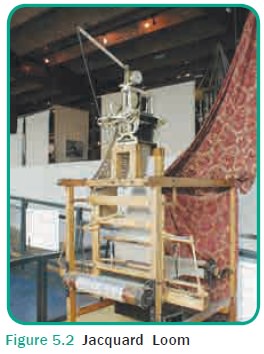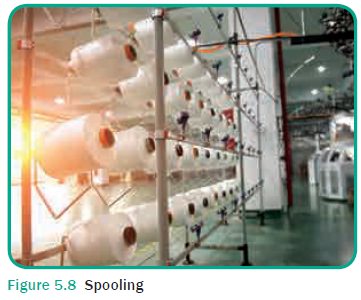Chapter: 11th Textiles and Dress Designing : Chapter 5 : Fabric Production
Weaving
WEAVING
Weaving is the simple technique of making a
fabric. The lengthwise and crosswise yarns are overlapped (interlaced) one
above the other in an alternative manner. This process of interlac-ing is done
on loom. Loom is a wooden / metal machine, which holds the warp yarns and
facilitates the weft yarn to pass up and below the warp to form the woven
structure.
The technique of fabric construc-tion by weaving
was probably known as spinning during the ancient times. In the course of time,
looms were made which were simple and hand operated. The fab-ric woven in these
looms is called hand loom fabric. Today power loom has taken place of the hand
operated loom which can weave fabric faster and with less defects in comparison
to hand looms (Figure 5.1).

Looms can be classified into vari-ous categories. This classification is based upon the picking operations used by the loom. The looms which use shuttles for weft insertion are called conventional shuttle or fly shuttle looms. The fabric woven in this loom has more defects as it used large wooden shuttle which causes abrasion resulting in more broken yarns. These looms are also very noisy and PPM (Picks Per Minute) is also low.
The looms which use other devices to bring the
filling yarn through the fabric are called shuttleless looms. These looms have
high productivity with fewer fabric faults (Figure 5.2).

The major parts of a loom are described below:
Major Parts of a Loom:
·
Warp
Beam: This is round roller/ cylinder
on to which the warp/ lengthwise yarns are arranged one after another in a
parallel manner (Figure 5.3).

·
Whip
Roll: A small guide roller over which
the warp yarns pass, as they move to the lease rod.
·
Lease
Rod: Two guide rod between the
whip roll and the heddles, to separate the alternative warp yarns.
·
Heddles:
Small
wire made out of steel. They are a
set of vertical wires laid into the hardness frame. This helps in the movement
of the warp yarns (Figure 5.4).

·
Harness:
A
wooden frame to sep-arate warp yarn such that a shed (V shaped gap) is formed,
through which weft thread is passed.
·
Bobbin:
Small
long plastic or metal holder on to
which the (filling) weft yarns are wound.
·
Shuttle:
A
wooden / plastic boat shaped device
which hold the bob-bin with the weft yarns. This moves from right to left
pulling the weft yarn in its place (Figure 5.5).

·
Reed: A
vertical wooden frame with very
close steel wires. Each warp yarns pass through each wire. The gap between the
wires is known as dents (Figure 5.6).

·
Breast
Beam: This is a bar, which guides
the newly woven cloth towards the cloth beam.
·
Cloth
Beam: A wood or steel roller on
to which the woven cloth is wound after weaving (Figure 5.7).

Basic Weaving Operation
The yarns intended for warp must pass through
some basic operations like– spooling, and warping to prepare them to withstand
the strain during weaving.
Spooling
Winding of warp yarns on large spools, or cones
which are placed on a rack called creel is known as spooling. These yarns are
then wound on the warp beam (Figure 5.8).

Sizing
The warp yarns are unwound and dipped in a sizing
bath which consists of starch. The slasher machine covers every yarn with a
coating which adds strength to the warp yarns to withstand the stress, during
weaving (Figure 5.9).

Warping
Warping is the process of winding the sized warp
yarns on the warp beam which will be placed over the loom. The warp beam is
located at the back of the loom and holds the lengthwise yarns. It controls and
releases the warp yarns as the weaving process is carried on. The warp ends are
threaded through the heddles held by the harness. Every basic loom has a
minimum of 2 heddles. The number of heddles in a loom varies from 2 to 12 for
basic weaves, but for fancy weaves the number increases upto 32. The heddles
help in the movement of warp yarn to form the shed, through which the shuttle
carries the filling yarns. Once the filling yarn is passed through then reed is
pushed to put the filling yarn in its place (Figure 5.10).

Fabric Making
The interlacing of warp and weft yarns results in
woven fabric making. This is done on a loom through four main pro-cesses. They
are shedding, picking, beating up and taking up and letting off processes.
·
Shedding can be described as raising the specific
warp yarns by the hard movement of the heddles; to form a ‘V’ shaped gap known
as shed for the weft yarns to interlace through.
·
Picking is the processing of
interlac-ing /passing the filling yarn (weft) through the shed formed from
right to left (Figure5.11).

·
Beating up is also known as bat-tening. This is
the process of push-ing the filling yarn (weft) firmly into its place by the
movement of the reed. Beating arranges the filling yarns parallel to each other
very closely to create a woven structure.
·
Taking up and letting off is the pro-cess of
winding up woven cloth into the cloth beam and releasing more warp yarns from
the warp beam for weaving.
Terms Used in Woven Fabrics
The common terms used while weaving are given
below :
Selvedges
Selvedges are the lengthwise edges which run on
both sides of the fabric. They are usually 0.5 to 1.5 cm broad. Selvedges
prevent the fabric from raveling. It is strong with more number of warp yarns.
There are different types of selvedges namely plain selvedge, tape selvedge,
split selvedge, fringe selvedge, fused sel-vedge and adhesive finished selvedge
(Figure 5.12).

Thread Count
The number of warp (ends) and weft (picks) per
square inch of fabric is called thread count or fabric count. The higher the
fabric count the more strong and more durable is the fabric. Fabric with higher
thread count is more expensive and is denoted by X x Y. Example 30 x 50 thread
count means 30 and 50 yarns in warp and weft direction for one inch. When the
number of warp and weft yarns are almost equal the construction of fabric is
called balanced and when the difference in warp or weft yarns is more than the
other, it is called an unbalanced construction.
Factors Affecting the Durability of the Fabric
The durability of a fabric depends on various
factors. The most common are listed below :
·
The kind and quality of the fibre.
·
The tensile strength of the yarn.
·
The amount of twist in the yarn.
·
The use of ply yarns as compared with singles.
·
The use of uniform yarn rather than novelty yarns
and
·
The compactness of a fabric.
Related Topics